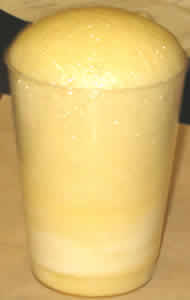Polyurethane Foam
SED 695B; Fall 2005
Overview:
This kit allows the creation of a 2-part polyurethane foam.

Topics addressed: Polymers, catalysis
Californa State Chemistry Standards:
Organic and Biochemistry
10. The bonding characteristics of carbon allow the formation of many different organic molecules of varied sizes, shapes, and chemical properties and provide the biochemical basis of life. As a basis for understanding this concept:
a.
Students know large molecules (polymers), such as proteins, nucleic acids, and starch, are formed by repetitive combinations of simple subunits. b.
Students know the bonding characteristics of carbon that result in the formation of a large variety of structures ranging from simple hydrocarbons to complex polymers and biological molecules.
Materials:
- Polyurethane Foam System (Part A and Part B)
- Disposable stirring rod
- Two disposable 12oz (approx.) clear plastic cups
- Paper towels
- Acetone for cleanup
Procedure:
Please refer to the illustrated procedure below.
Results and Discussion:
Part A is a viscous cream-colored liquid containing a polyether polyol, a silicone surfactant, and a catalyst. The polyether polyol is a substance such as polypropylene glycol. The hydroxyl end of the polymer is the reactive site. The silicone surfactant reduces the surface tension between the liquids. The catalyst is a tertiary amine which aids in speeding up the reaction without chemically changed itself.
Part B is a dark brown viscous liquid containing diphenylmethane diisocyanate and higher oligomers of diisocyanate. When the polyether polyol (Part A) is mixed with the diisocyanate (Part B), an exothermic reaction occurs, producing polyurethane.
During the course of the polymerization reaction, a small amount of water reacts with some of the diisocyanate. A decomposition reaction occurs and produces carbon dioxide gas, thus causing the solution to foam and expand in volume. Pores in the mixture are created from the gas; these pores are visible when looking at the rigid substance. The multifunctionality of both reactants leads to a high degree of crosslinking in the polymer, causing it to become rigid within minutes.




Spread a paper towel flat on the table, and place one of the cups in the center of the paper towel.
Pour the content of the other cup into the cup on the towel..




References & Links:
Rosato, D. V. Rosato's Plastics Encyclopedia and Dictionary; Hanser: New York, 1993; pp. 318-320, 572
Shakashiri, B. Z. Chemical Demonstrations : A Handbook for Teachers of Chemistry; University of Wiscousin: Madison, 1983; Vol. 1, pp. 216-218